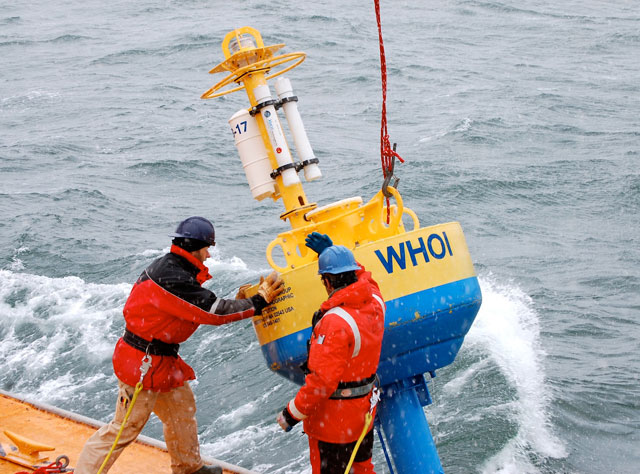|
Iron deficientResearch cruise tracks down sources of trace element key to phytoplankton bloomsPosted May 25, 2012
Iron deficiency in humans is a common condition that can cause fatigue or weaken the immune system. In the surface waters of the ocean, where microscopic plants called phytoplankton live, the lack of iron limits the productivity of these organisms that form the base of the food web. For people, the source of iron for a healthy diet is no secret. In the frigid waters of the Southern Ocean, the sources of iron that fuel blooms of phytoplankton, which serve as food for critters like the shrimp-like krill, are less clear. Until now. A team of scientists on a seven-week cruise to the Ross Sea aboard the research vessel Nathaniel B. Palmer The expedition took the researchers to Antarctica’s largest ice shelf and a biologically productive polynya, an area of open water surrounded by sea ice, among other locations. Using a variety of instruments — from a high-tech camera towed through water to a specially designed conductivity, temperature and depth (CTD) rosette system used to sample water — the scientists mapped water masses, measured iron content and collected biological specimens. “It was a truly interdisciplinary project involving physics, biology and chemistry,” said Dennis McGillicuddy The mesoscale refers to the physical scale of processes studied — in this case, ocean features that are a few tens of kilometers in size. The rest of the title requires a bit more background. There are a number of microscopic plants and animals in the surface waters of the ocean that are collectively known as plankton. Phytoplankton are the plant portion of that complex biological assemblage, mostly consisting of single-celled algae. Like terrestrial plants, phytoplankton use a process called photosynthesis to capture light from the sun and convert it into chemical energy stored in the form of carbohydrate. They also rely on nutrients in the water for growth, also not unlike how garden plants use nutrients in the soil. The Ross Sea is particularly rich in the macronutrients nitrate, phosphate and silicate. In fact, based on the high abundance of such nutrients and the 24-hour sunlight of the Antarctic summer, scientists were puzzled as to why the Southern Ocean wasn’t productive enough to utilize all the nutrients. Back in 1988, John Martin and Steve Fitzwater finally offered an explanation in the journal Nature — iron-deficient waters. “It’s kind of ironic that iron is limiting for phytoplankton. Iron is the fourth most abundant element in the Earth’s crust, but it’s in very low supply to surface waters of the ocean,” noted McGillicuddy, a senior scientist at Woods Hole Oceanographic Institution The problem is particularly acute in the Southern Hemisphere due to geography — an absence of landmasses. Dust deposition is one of the key pathways for how iron makes its way to the ocean surface. Glance at a globe: The Northern Hemisphere is heavy with continental landmasses, unlike the flipside of the equator. “That’s what makes the Southern Hemisphere so different in terms of its iron cycling,” McGillicuddy said. Still, iron is making its way into the surface waters of the Southern Ocean, sparking phytoplankton blooms so large that the greenish color of the chlorophyll can be seen by satellites from space. The PRISM scientists hypothesized four possible sources of iron: circumpolar deep water intruding onto the continental shelf; sediments on shallow banks and near-shore areas; melting sea ice around the perimeter of the Ross Sea polynya; and glacial meltwater from the Ross Ice Shelf. “The bottom line is that all four of our hypothesized sources are contributing to the iron budget,” McGillicuddy said.1 2 Next |



For USAP Participants |
For The Public |
For Researchers and EducatorsContact UsU.S. National Science FoundationOffice of Polar Programs Geosciences Directorate 2415 Eisenhower Avenue, Suite W7100 Alexandria, VA 22314 Sign up for the NSF Office of Polar Programs newsletter and events. Feedback Form |



